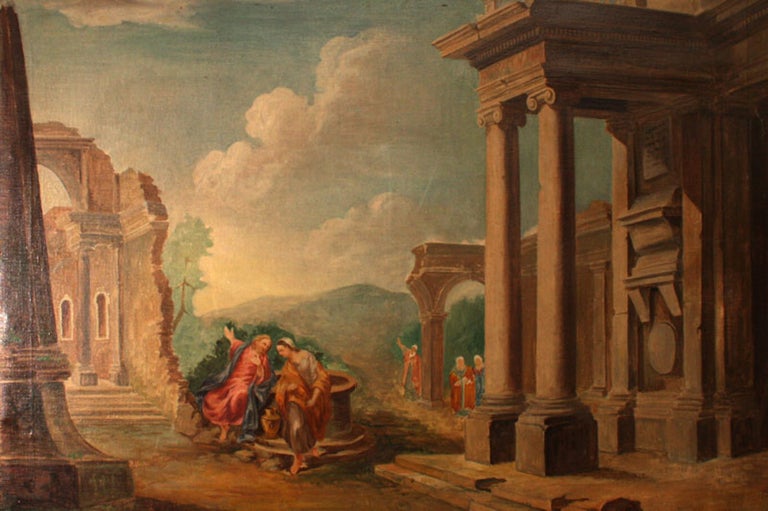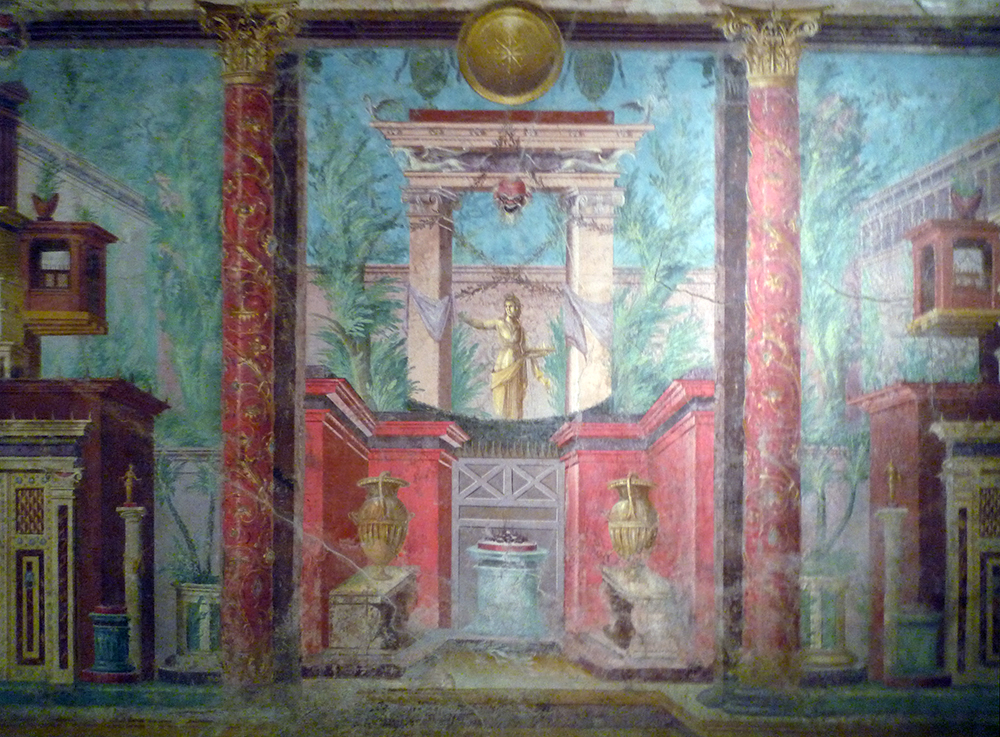Roman Paintings. The interiors of Roman buildings of all description were very frequently sumptuously decorated using bold colours and designs. Our collection of Roman paintings has everything from classical works to intriguing, interpretive images by today's artists.
Fresco Wall from the House of Livia. The Roman catacombs gave rise to the foremost bodies of Early Christian painting (in the form of murals) and sculpture (in the form of sculpted tombs). The Roman wall paintings in Pompeii that Mau categorized were true frescoes (or buon fresco), meaning that pigment was applied to wet plaster, fixing the pigment to the wall.
A ncient Roman artwork was traditionally viewed as being nothing more than a copy of the Greek style, however, more recent re-analyses of Roman paintings and sculptures have revealed how stylistically eclectic their influences really were. The painting is a cheerful depiction of the Roman festival Veneralia that honors Venus Verticordia. Roman paintings have not survived on a large scale; however, there are murals from Pompeii depicting seaside life, paintings in the Catacombs, the grottos of Nero's palace, and the Fayum mummy portraits which are portraits of living people attached to their burial housing after death.
Fresco Wall from the House of Livia. Paintings have also been found in other places, most notably in villas and tombs. Roman artists were masters at adapting Greek imagery for entirely new functions and contexts.
A ncient Roman artwork was traditionally viewed as being nothing more than a copy of the Greek style, however, more recent re-analyses of Roman paintings and sculptures have revealed how stylistically eclectic their influences really were.
Designs could range from intricate realistic.
Rubens was inspired by Titian and made a copy of his work The. Whether you're a poet or modern-day gladiator, these images of ancient warriors and scholars still speak their truth. The miraculous Feast of Venus is a Roman Mythology painting by the most celebrated Flemish artist Peter Paul Rubens, known for his impressive large scale historical paintings commissioned by the courts around XVII century Europe.
For over two thousand years, the Roman Empire was the epicenter of the civilized world. In addition to Metrodorus and Demetrius, ancient. A key aspect of Roman public art was the commemoration of important individuals, and the later Republic is a period of striking portraits of leading Romans, partly following native veristic traditions of portraiture and partly influenced by Hellenistic interest in physiognomy.
Cupid Hercules (Mythology) Medusa Narcissus (Mythology) Nymphs Venus (Goddess of Love) Zeus. Most of what is left of Roman painting comes from Pompeii. C.) drew upon examples of early Hellenistic (late fourth.
Roman art was born for the second time, this time under the influence of the defeated. Artists of the late Republican period (second to first century B. Sculpture was perhaps considered as the.
And happily, the House of Livia preserves nearly all of its magnificent charm for contemporary art lovers. Roman art was born for the second time, this time under the influence of the defeated. Each rectangle of painted "marble" was connected by stucco mouldings.
The painting is a cheerful depiction of the Roman festival Veneralia that honors Venus Verticordia.
The wall paintings that were found made art historians rethink their notions about the retreat from naturalism in the late Roman Empire that had hitherto been associated with the rise of Christianity.
The interiors of Roman buildings of all description were very frequently sumptuously decorated using bold colours and designs. Roman paintings have not survived on a large scale; however, there are murals from Pompeii depicting seaside life, paintings in the Catacombs, the grottos of Nero's palace, and the Fayum mummy portraits which are portraits of living people attached to their burial housing after death. Paintings have also been found in other places, most notably in villas and tombs.
Roman art was born for the second time, this time under the influence of the defeated. Readers of my recent novel, The Masterpiece, have asked what happened to Roman's landscape, based on a line Grace drew to get him started on a new project, and "The Indwelling" - an oil painting of Mary pregnant with Jesus. Sculpture was perhaps considered as the.
Any material could be used and there was a great interest in realism, seen particularly in portraits and depictions of. And happily, the House of Livia preserves nearly all of its magnificent charm for contemporary art lovers. Roman paintings have not survived on a large scale; however, there are murals from Pompeii depicting seaside life, paintings in the Catacombs, the grottos of Nero's palace, and the Fayum mummy portraits which are portraits of living people attached to their burial housing after death.
Modern scholars point out the influence from not only Greek models, but also the native Italic, the Etruscan culture, and even the Egyptian culture. Our collection of Roman paintings has everything from classical works to intriguing, interpretive images by today's artists. And happily, the House of Livia preserves nearly all of its magnificent charm for contemporary art lovers.
And happily, the House of Livia preserves nearly all of its magnificent charm for contemporary art lovers. Since catacomb paintings were intended mainly to communicate the importance of biblical figures and events (rather than to serve as beautiful works of art), they shun realism. Pompeii is the source of what we know about a lot of things from ancient Rome.
Despite this durable technique, painting is still a fragile medium and, once exposed to light and air, can fade significantly, so the paintings discovered in Pompeii were.
Each rectangle of painted "marble" was connected by stucco mouldings.
C.) was largely an exploration of simulating marble of various colors and types on painted plaster. C.) drew upon examples of early Hellenistic (late fourth. Since catacomb paintings were intended mainly to communicate the importance of biblical figures and events (rather than to serve as beautiful works of art), they shun realism.
The work of these painters is known from literary. Since catacomb paintings were intended mainly to communicate the importance of biblical figures and events (rather than to serve as beautiful works of art), they shun realism. This painting depicts a battle between Alexander the Great and Darius III of Persia.
The interiors of Roman buildings of all description were very frequently sumptuously decorated using bold colours and designs. This painting depicts a battle between Alexander the Great and Darius III of Persia. Roman artists were masters at adapting Greek imagery for entirely new functions and contexts.
And happily, the House of Livia preserves nearly all of its magnificent charm for contemporary art lovers.
A key aspect of Roman public art was the commemoration of important individuals, and the later Republic is a period of striking portraits of leading Romans, partly following native veristic traditions of portraiture and partly influenced by Hellenistic interest in physiognomy.
Paintings have also been found in other places, most notably in villas and tombs. Since catacomb paintings were intended mainly to communicate the importance of biblical figures and events (rather than to serve as beautiful works of art), they shun realism. Nothing from Greek painting was given by sources of the names of great painters like Polignot, Zeuksis, Parrazjos or Apollodoros, who lived between the fifth and third century BCE.
Art historians and archaeologists describe the development of Roman painting in four styles. It can be viewed at the National Archaeological Museum in Naples. Since catacomb paintings were intended mainly to communicate the importance of biblical figures and events (rather than to serve as beautiful works of art), they shun realism.
Paintings have also been found in other places, most notably in villas and tombs. The Roman wall paintings in Pompeii that Mau categorized were true frescoes (or buon fresco), meaning that pigment was applied to wet plaster, fixing the pigment to the wall. Roman art was born for the second time, this time under the influence of the defeated.
Artists of the late Republican period (second to first century B. Whether you're a poet or modern-day gladiator, these images of ancient warriors and scholars still speak their truth. Art Deco Asian Bohemian Coastal French Country Glam Modern/Contemporary Photography Rustic Scandinavian Traditional Show More. art type.


















